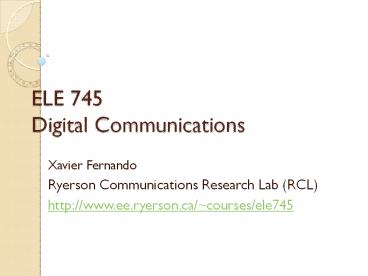ELE 745 Digital Communications - PowerPoint PPT Presentation
Title:
ELE 745 Digital Communications
Description:
138,000 ICT engineers hired in US in 2006 compared to 14000 in biomedical ... Satellite: Telephony, Spying, GPS, XM radio. Why DIGICOM? ... – PowerPoint PPT presentation
Number of Views:160
Avg rating:3.0/5.0
Title: ELE 745 Digital Communications
1
ELE 745 Digital Communications
- Xavier Fernando
- Ryerson Communications Research Lab (RCL)
- http//www.ee.ryerson.ca/courses/ele745
2
Why DIGICOM?
- Basic DIGICOM knowledge is needed for all
electrical/computer engineers - Power systems rely more more communications to
become Smart Grids - Inter chip and intra-chip communications connect
micro electronic systems - Multimedia, control and instrumentation systems
use communications - Biomedical engineers use body area networks for
communications
3
DIGICOM is everywhere
- Wireless has become a necessity
- Wireless LANs, 802.11, 15, 16, Cellular, LTE, 3G,
4G - Optical Communications
- Almost all phone calls, Most Internet traffic,
and Television channels travels via optical fiber - Copper wires
- Coaxial cable and twisted pair telephone wires
(DSL) are the key for Triple play services
(voice, data, TV) - Satellite
- GPS, XM radio and lot more
One fiber can carry up to 6.4 Tb/s or 100 million
conversations simultaneously
4
Employment Statistics - 2008 (US)
- Electrical engineers (power) - 157,800
- Information and Communication Technology (ICT)
engineers - 218,400 - Computer hardware - 74,700
- others - 143700
- Biomedical engineers 16,000
- (http//www.bls.gov/oco/ocos027.htm)
5
International Telecom Market is 2.7 Trillion in
2009
North America 1.2T
6
The Wireless Boom
- 2.6 billion mobile phone users worldwide today
- vs. 1.3 billion fixed landline phones
- vs. 1.5 billion TV sets in use
- Expected to grow to 4.1 billion by 2014
- 37 increase in users over next 6 years
- Source Telecom Trends International Inc.
(February 2008) - Worldwide RFID revenues estimated to reach 1.2
billion in 2008 - 31 increase over 2007 revenues
- Estimated to reach 3.5 billion by 2012
- Source Gartner Research Firm report cited in
RFID World February 26, 2008
7
Wireless Leaders - 2009
- China Mobile 60.16 B
- Vodafone 59.60 B
- Telefónica 51.56 B
- T-Mobile/DT 50.16 B
- ATT Mobility 49.34 B
8
Part - I
- Digital Communications
9
System Overview
10
System Overview
- Information Source
- Analog (voice) or digital (e-mail, SMS, fax)
- Source Encoding
- Removing redundancy (to reduce bit rate)
- Encrypt introduce security (optional)
- Channel Encoding
- Adding redundancy to overcome channel impairments
such as noise distortion - Multiplex Share the channel with other sources
11
System Overview
- Pulse Modulation
- Generate waveform suitable for transmission
- Bandpass (Passband) Modulation
- Translate the baseband waveform to passband using
a carrier
12
The Channel
- Different Channels Telephone wire, TV (coaxial)
Cable, air (wireless), optical fiber - The channel adds noise and distortion
- Often adds white Gaussian noise and called AWGN
channel - Distortion comes from multipath dispersion (in
air), inductance, capacitance etc. - The channel could be stationary (wires) or time
varying (wireless) - The channel is usually band-limited (lowpass or
bandpass - Optical fiber channel offers huge bandwidth
13
Why Digital?
- Analog receiver need to exactly reproduce the
waveform, removing noise and distortion - Digital receiver only need to make a discrete
decision (0 or 1?)
14
Why Digital?
- Complete clean-up and regeneration is possible
- Advanced processing is possible, such as
- Channel coding (Ex parity)
- Source coding (compression)
- Encryption watermarking
- Multiplexing different users (TDMA, CDMA)
- Multiplexing data from different sources (voice,
video, data, medical) - Lossless storing and retrieval
- Much more
15
An Example
16
Basics of Signals
17
Deterministic and Random Signals
- Deterministic signals have known value at any
time. Explicit equations can be written - Ex
- Random signals are unknown a priory
- No equations can be written for the waveform
- Statistical properties (mean, variance etc) are
used - Ex Noise, Information
18
Periodic signals are everlasting signals
Continuous and discrete time signals
Continuous (time) signal exists in all times
The Unit Impulse Function
19
Energy Signal That has finite Energy for all
time
Power Signal That has finite power for all time
20
Energy Spectral Density
Since for real signals, X(f) is an even function
of frequency,
21
Power Spectral Density (Periodic Signal)
Power
PSD
PSD of an aperiodic signal
22
Autocorrelation of a Periodic Signal
Properties 1-3 are the basic properties
23
Autocorrelation of an Energy Signal
Properties 1-3 are the basic properties
24
(No Transcript)
25
Ideal Filters
26
Practical Filter
27
Baseband and Pass band Spectrum

